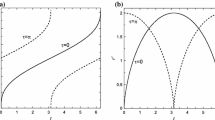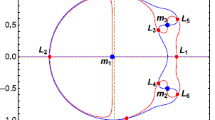Abstract
We study the change of phase space structure of the rectilinear three-body problem when the mass combination is changed. Generally, periodic orbits bifurcate from the stable Schubart periodic orbit and move radially outward. Among these periodic orbits there are dominant periodic orbits having rotation number (n − 2)/n with n ≥ 3. We find that the number of dominant periodic orbits is two when n is odd and four when n is even. Dominant periodic orbits have large stable regions in and out of the stability region of the Schubart orbit (Schubart region), and so they determine the size of the Schubart region and influence the structure of the Poincaré section out of the Schubart region. Indeed, with the movement of the dominant periodic orbits, part of complicated structure of the Poincaré section follows these orbits. We find stable periodic orbits which do not bifurcate from the Schubart orbit.
Similar content being viewed by others
References
Birkhoff G.D.: Proof of Poincaré’s geometric theorem. Trans. Am. Math. Soc. 14, 14–22 (1913)
Chirikov B.V.: A universal instability of many-dimensional oscillator systems. Phys. Rep. 52, 263–379 (1979)
Contopoulos G.: Order and Chaos in dynamical astronomy, pp. 139–143. Springer, Berlin (2002)
Hénon M.: Numerical exploration of the restricted problem. VI. Hill’s case: Non-periodic orbits. Astron. Astrophys. 9, 24–36 (1970)
Hietarinta J., Mikkola S.: Chaos in the one-dimensional gravitational three-body problem. CHAOS 3, 183–203 (1993)
McGehee R.: Triple collision in the collinear three-body problem. Inventiones Mathematicae 27, 191–227 (1974)
Mikkola S., Hietarinta J.: A numerical investigation of the one-dimensional Newtonian three-body problem I. Celest. Mech. Dyn. Astron. 46, 1–18 (1989)
Mikkola S., Hietarinta J.: A numerical investigation of the one-dimensional Newtonian three-body problem III. Celest. Mech. Dyn. Astron. 51, 379–394 (1991)
Moser J.: Stability of the asteroids. Astron. J. 63, 439–443 (1958)
Orlov V.V., Petrova A.V., Tanikawa K., Saito M.M., Martynova A.I.: The rectilinear three-body problem. Celest. Mech. Dyn. Astron. 100, 93–120 (2008)
Saito M.M., Tanikawa K.: Collinear three-body problem with non-equal masses by symbolic dynamics. ASP Conf. Ser. 316, 63–69 (2004)
Saito M.M., Tanikawa K.: The rectilinar three-body problem using symbol sequence I. Role of triple collision. Celest. Mech. Dyn. Astron. 98, 95–120 (2007)
Sano M.: The classical Coulomb three-body problem in the collinear eZe configuration. J. Phys. A Math. Gen. 37, 803–822 (2004)
Schubart J.: Losungen im Dreikörper problem. Astronomische Nachrichten 283, 17–22 (1956)
Tanikawa K., Mikkola J.: Triple collisions in the one-dimensional three-body problem. Celest. Mech. Dyn. Astron. 76, 23–34 (2000)
Tanikawa K., Mikkola J.: One-dimensional three-body problem via symbolic dynamics. CHAOS 10, 649–657 (2000)
Author information
Authors and Affiliations
Corresponding author
Rights and permissions
About this article
Cite this article
Saito, M.M., Tanikawa, K. The rectilinear three-body problem using symbol sequence II: role of the periodic orbits. Celest Mech Dyn Astr 103, 191–207 (2009). https://doi.org/10.1007/s10569-008-9175-0
Received:
Accepted:
Published:
Issue Date:
DOI: https://doi.org/10.1007/s10569-008-9175-0




